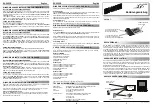
4-19
PA-5EFL Ethernet 10Base-FL Port Adapter Installation and Configuration
OL-3495-02
Chapter 4 Configuring the PA-5EFL Port Adapter
Checking the Configuration
0 output errors, 0 collisions, 0 interface resets, 0 restarts
0 output buffer failures, 0 output buffers swapped out
Proceed to the next section
“Using the ping Command to Verify Network Connectivity”
to check
network connectivity of the PA-5EFL and switch or router.
Using the ping Command to Verify Network Connectivity
Using the
ping
command, you can verify that an interface port is functioning properly. This section
provides a brief description of this command. Refer to the publications listed in the
“Related
Documentation” section on page vi
for detailed command descriptions and examples.
The
ping
command sends echo request packets out to a remote device at an IP address that you specify.
After sending an echo request, the system waits a specified time for the remote device to reply. Each
echo reply is displayed as an exclamation point (!) on the console terminal; each request that is not
returned before the specified timeout is displayed as a period (.). A series of exclamation points (!!!!!)
indicates a good connection; a series of periods (.....) or the messages [timed out] or [failed] indicate a
bad connection.
Following is an example of a successful
ping
command to a remote server with the address 10.0.0.10:
Router# ping 10.0.0.10 <Return>
Type escape sequence to abort.
Sending 5, 100-byte ICMP Echoes to 10.0.0.10, timeout is 2 seconds:
!!!!!
Success rate is 100 percent (5/5), round-trip min/avg/max = 1/15/64 ms
Router#
If the connection fails, verify that you have the correct IP address for the destination and that the device
is active (powered on), and repeat the ping command.
Proceed to the next section
“Using loopback Commands”
to finish checking network connectivity.
Using loopback Commands
With the loopback test you can detect and isolate equipment malfunctions by testing the connection
between the PA-5EFL interface and a remote device such as a modem or a CSU/DSU. The
loopback
subcommand places an interface in loopback mode, which enables test packets that are generated from
the
ping
command to loop through a remote device or compact serial cable. If the packets complete the
loop, the connection is good. If not, you can isolate a fault to the remote device or compact serial cable
in the path of the loopback test.
Depending on the mode of the port, issuing the
loopback
command checks the following path:
•
When no compact serial cable is attached to the PA-5EFL interface port, or if a DCE cable is
attached to a port that is configured as line protocol up, the
loopback
command tests the path
between the network processing engine and the interface port only (without leaving the network
processing engine and port adapter).
•
When a DTE cable is attached to the port, the
loopback
command tests the path between the network
processing engine and the near (network processing engine) side of the DSU or modem to test the
PA-5EFL interface and compact serial cable.


































